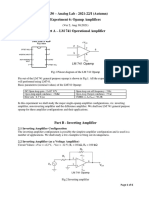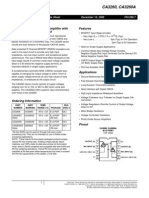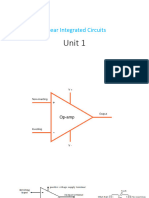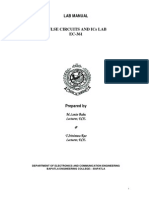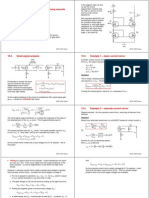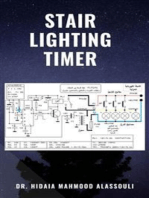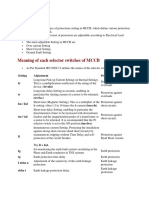Lecture 20 Transistor Amplifiers (II) : Other Amplifier Stages November 17, 2005
Lecture 20 Transistor Amplifiers (II) : Other Amplifier Stages November 17, 2005
Uploaded by
srabon1059Copyright:
Available Formats
Lecture 20 Transistor Amplifiers (II) : Other Amplifier Stages November 17, 2005
Lecture 20 Transistor Amplifiers (II) : Other Amplifier Stages November 17, 2005
Uploaded by
srabon1059Original Description:
Original Title
Copyright
Available Formats
Share this document
Did you find this document useful?
Is this content inappropriate?
Copyright:
Available Formats
Lecture 20 Transistor Amplifiers (II) : Other Amplifier Stages November 17, 2005
Lecture 20 Transistor Amplifiers (II) : Other Amplifier Stages November 17, 2005
Uploaded by
srabon1059Copyright:
Available Formats
6.
012 Microelectronic Devices and Circuits Fall 2005
Lecture 201
Lecture 20 Transistor Ampliers (II) Other Amplifier Stages November 17, 2005 Contents: 1. Commonsource amplier (cont.) 2. Commondrain amplier 3. Commongate amplier
Reading assignment: Howe and Sodini, Ch. 8, 8.78.9
6.012 Microelectronic Devices and Circuits Fall 2005
Lecture 202
Key questions What other amplier stages can one build with a sin gle MOSFET and a current source? What is the uniqueness of these other stages?
6.012 Microelectronic Devices and Circuits Fall 2005
Lecture 203
1. Commonsource amplier with currentsource supply
VDD
iSUP signal source RS vs VGG iD + vOUT signal load RL
VSS
Loadline view:
iSUP=ID load line VGG-VSS=VDD-VSS
ISUP
VGG-VSS
VGG-VSS=VT 0 VSS VDD VOUT
6.012 Microelectronic Devices and Circuits Fall 2005
Lecture 204
Current source characterized by high output resistance: roc. Then, unloaded voltage gain of commonsource stage: |Avo | = gm (ro //roc ) signicantly higher than amplier with resistive supply. Can implement current source supply by means of p channel MOSFET:
VDD
VB signal source RS vs VGG
iSUP
iD
+ vOUT
VSS
6.012 Microelectronic Devices and Circuits Fall 2005
Lecture 205
Relationship between circuit gures of merit and device parameters Remember: gm = 2
W nCox ID L
1 L ro nID ID Then: Circuit Parameters Device |Avo | Rin Rout Parameters gm (ro//roc ) ro//roc ISU P
W
nCox
L
adjustments are made to VGG so none of the other parameters change CS amp with current supply source is good voltage am plier (Rin high and |Av | high), but Rout high too voltage gain degraded if RL ro//roc .
6.012 Microelectronic Devices and Circuits Fall 2005
Lecture 206
Commonsource amplier is acceptable voltage amplier (want high Rin, high Avo , low Rout ):
RS + vin Rout + vout
vs
Rin
Avovin
RL
... but excellent transconductance amplier (want high Rin, high Gmo , high Rout ):
RS + vin iout
vs
Rin
Gmovin
Rout
RL
For commonsource amplier: Gmo = gm
6.012 Microelectronic Devices and Circuits Fall 2005
Lecture 207
Commonsource amplier does not work as transresis tance amplier (want low Rin, high Rmo , low Rout ):
iin Rout + vout
is
RS
Rin
Rmoiin
RL
nor as current amplier (want low Rin, high Aio , high Rout ):
iin iout
is
RS
Rin
Aioiin
Rout
RL
Need new amplier congurations.
6.012 Microelectronic Devices and Circuits Fall 2005
Lecture 208
2. Commondrain amplier
VDD signal source RS signal load RL
vs iSUP
+ vOUT
VGG VSS
How does it work? VGG, ISU P , and W/L selected to bias MOSFET in saturation, obtain desired output bias point, and de sired output swing. vG iD cant change vOU T (source follower) to rst order, no voltage gain: vout vs but Rout small: eective voltage buer stage (good for making voltage amp in combination with commonsource stage).
6.012 Microelectronic Devices and Circuits Fall 2005
Lecture 209
Smallsignal analysis Unloaded smallsignal equivalent circuit model:
+ +
G gmvgs
vgs vin
- S
ro
+
roc
-
vout
-
+ vgs -
vin
-
gmvgs
ro//roc
vout
-
vin = vgs + vout vout = gmvgs(ro //roc) Then: Avo = gm 1 1 gm + ro //roc
6.012 Microelectronic Devices and Circuits Fall 2005
Lecture 2010
Input impedance: Rin = Output impedance:
+ + vgs -
it
+
RS
vin
-
gmvgs
ro//roc
vt
vgs=-vt effectively:
resistance of
value 1/gm
it
+
gmvt
ro//roc
vt
Rout small!
1 1 = 1 gm + ro //roc gm
Loaded voltage gain: Av = Avo RL RL 1 1 RL + Rout RL + gm
6.012 Microelectronic Devices and Circuits Fall 2005
Lecture 2011
Eect of back bias: If MOSFET not fabricated on isolated pwell, then body is tied up to wafer substrate (connected to VSS ):
VDD signal source RS VSS vs iSUP vOUT VGG VSS + signal load RL
Two consequences: Bias aected: VT depends on VBS = VSS VOU T = 0 Smallsignal gures of merit aected: signal shows up between B and S (vbs = vout).
6.012 Microelectronic Devices and Circuits Fall 2005
Lecture 2012
Smallsignal equivalent circuit model:
G gmvgs gmbvbs
D
vgs vin
- S -
ro
+
vbs
+B
roc
vout
-
vbs=-vout
+ vgs -
vin
-
gmvgs
gmbvout
ro//roc
vout
-
gm gm Avo = <1 1 gm + gmb + ro //roc gm + gmb Also: Rout = 1
1 gm + gmb + ro //roc
1 gm + gmb
6.012 Microelectronic Devices and Circuits Fall 2005
Lecture 2013
Relationship between circuit gures of merit and device parameters: gm =
2
W nCox ID L
gmb
= gm 2 2p VBS
Circuit Parameters Device |Avo | Rin Rout 1 Parameters gmgm mb
gm+gmb +g ISU P W nCox L
adjustments are made to VGG so none of the other parameters change CD amp useful as a voltage buer to drive small loads (in a multistage amp, other stages will be used to provide voltage gain).
6.012 Microelectronic Devices and Circuits Fall 2005
Lecture 2014
3. Commongate amplier Need to handle currentmode signal sources:
VDD
iSUP iOUT VSS signal source is RS signal load RL
IBIAS
VSS
How does it work? since source is signal input terminal, body cannot be tied up to source (Cdb is signicant) iSU P , IBIAS , and W/L selected to bias MOSFET in saturation, obtain desired output bias point, and de sired output swing iS iD iOU T no current gain: is = iout (current buer)
6.012 Microelectronic Devices and Circuits Fall 2005
Lecture 2015
Bias: select ISU P , IBIAS , and W/L to get proper qui escent IOU T and keep MOSFET in saturation.
VDD
ISUP IOUT VSS
IBIAS
VSS
ISU P + IOU T + IBIAS = 0 Select bias so that IOU T = 0 VOU T = 0. Assume MOSFET in saturation (no channel modulation): ID = W nCox (VGS VT )2 = ISU P = IBIAS 2L
but VT depends on VBS : VT = VT o + n( 2p VBS 2p ) Must solve these two equations iteratively to get VS .
6.012 Microelectronic Devices and Circuits Fall 2005
Lecture 2016
Smallsignal circuit (unloaded)
+ G D
iout
vgs
- S -
gmvgs
gmbvbs
ro roc
vbs
+ B
is
vbs=vgs
is
vgs
+
gmvgs
gmbvgs
ro
iout
is
gm
gmb
ro
iout
is = iout Aio =
iout = 1 is
Not surprising, since in a MOSFET: ig = 0.
6.012 Microelectronic Devices and Circuits Fall 2005
Lecture 2017
Input resistance:
+
vgs
+
gmvgs
gmbvgs
ro roc RL
it
vt
-
vgs=-vt
gmvt it vt
gmbvt
ro
roc//RL
-
Do KCL on input node: vt (roc //RL )it it gmvt gmbvt =0 ro Then: 1 + roc //RL 1 ro Rin = gm + gmb + r1o gm + gmb Very small.
6.012 Microelectronic Devices and Circuits Fall 2005
Lecture 2018
Output resistance:
+
vgs
-
gmvgs
gmbvgs
ro roc
+ -
it vt
RS
vgs
-
gmvgs
gmbvgs
ro
+ -
it' vt'
RS
Do KCL on input node: it Notice also: vgs = itRS Then: Rout 1 = roc//{ro [1+RS (gm +gmb + )]} roc//[ro (1+gm RS )] ro
vt + vgs gmvgs gmb vgs =0 ro
Very large, because of the feedback eect of RS .
6.012 Microelectronic Devices and Circuits Fall 2005
Lecture 2019
Summary of MOSFET amplier stages:
stage
common source
Avo , Gmo , Aio
Gmo = gm
Rin
Rout
ro //roc
key function
transconductance amp.
common drain
Avo
gm gm +gmb
1 gm +gmb
voltage buer
common gate
Aio 1
1 gm +gmb
roc //[ro(1 + gm RS )]
current buer
In order to design ampliers with suitable performance,
need to combine these stages multistage ampliers
6.012 Microelectronic Devices and Circuits Fall 2005
Lecture 2020
Key conclusions
Dierent MOSFET stages designed to accomplish dier ent goals: Commonsource stage:
large voltage gain and transconductance, high in put resistance, large output resistance excellent transconductance amplier, reasonable volt age amplier Commondrain stage:
no voltage gain, but high input resistance and low output resistance good voltage buer Commongate stage:
no current gain, but low input resistance and high output resistance good current buer
You might also like
- Project Report of Public Address SystemDocument14 pagesProject Report of Public Address SystemZohaib Jahan50% (2)
- Installation Manual MD 200 & MD 300Document50 pagesInstallation Manual MD 200 & MD 300Ubaid ur Rehman100% (1)
- Lec 19Document20 pagesLec 19jeremiahreason1997No ratings yet
- Makalah Signal ConditioningDocument64 pagesMakalah Signal Conditioningw4w4n_s3mk4n1s4No ratings yet
- Lecture 17 - Linear Amplifier Basics - Outline: - AnnouncementsDocument14 pagesLecture 17 - Linear Amplifier Basics - Outline: - Announcementsishanksinghthandi100% (2)
- Chapter 9Document13 pagesChapter 9Huy HoNo ratings yet
- Cmos Delay TimeDocument17 pagesCmos Delay TimeCuong LaidangNo ratings yet
- BE Thesis 3. Project Final Endsem Presentation Current Mode CircuitsDocument61 pagesBE Thesis 3. Project Final Endsem Presentation Current Mode CircuitsGHNo ratings yet
- Chap05 (7 5 06)Document60 pagesChap05 (7 5 06)Amar NathNo ratings yet
- EE 230 - Analog Lab - 2021-22/I (Autumn) Experiment 6: Opamp AmplifiersDocument6 pagesEE 230 - Analog Lab - 2021-22/I (Autumn) Experiment 6: Opamp AmplifiersSruthiNo ratings yet
- 05 BJT-Amplifiers PDFDocument40 pages05 BJT-Amplifiers PDFMd ArifNo ratings yet
- Ec 352 Ic PDC PDFDocument73 pagesEc 352 Ic PDC PDFminhtrieudoddtNo ratings yet
- Unit 1Document82 pagesUnit 1Shaleva SinghNo ratings yet
- Ca3260, Ca3260A: 4Mhz, Bimos Operational Amplifier With Mosfet Input/Cmos Output FeaturesDocument4 pagesCa3260, Ca3260A: 4Mhz, Bimos Operational Amplifier With Mosfet Input/Cmos Output FeaturesPaulo Cesar SimonettiNo ratings yet
- +5V, Fail-Safe, 40Mbps, Profibus RS-485/ RS-422 TransceiversDocument15 pages+5V, Fail-Safe, 40Mbps, Profibus RS-485/ RS-422 TransceiversJuan Carlos HernandezNo ratings yet
- Datasheet 1Document18 pagesDatasheet 1shashwatthakurNo ratings yet
- Lecture 8 - Multistage AmplifiersDocument43 pagesLecture 8 - Multistage AmplifiersRanjan KarkiNo ratings yet
- L01 Operational AmplifierDocument27 pagesL01 Operational AmplifierRamaDinakaran100% (1)
- EC &LD-Lab ManualDocument50 pagesEC &LD-Lab Manualdevirpasad100% (1)
- EE42 100 Wb-Lecture19 080713-FDocument37 pagesEE42 100 Wb-Lecture19 080713-FozanistzNo ratings yet
- Chapter 6 - OpAmpDocument7 pagesChapter 6 - OpAmpOm PrakashNo ratings yet
- Lecture 20 An Not atDocument20 pagesLecture 20 An Not atapi-3721075No ratings yet
- Lesson 4 - RL RS EffectDocument35 pagesLesson 4 - RL RS EffectditmemayNo ratings yet
- Sir Syed CASE Institute of Technology, Islamabad Electronics LabDocument6 pagesSir Syed CASE Institute of Technology, Islamabad Electronics LabHamza AliNo ratings yet
- Lab 1 Power SupplyDocument7 pagesLab 1 Power SupplyKatherine YenNo ratings yet
- Ir 2213Document14 pagesIr 2213Lampros LampropoulosNo ratings yet
- Pertemuan6 Diode AplcDocument46 pagesPertemuan6 Diode AplcmbloexNo ratings yet
- Class D Tutorial 2Document74 pagesClass D Tutorial 2Gerardo Mendez CamarilloNo ratings yet
- NPN BJT Amplifier Stages: Common-Emitter (CE) : EE 105 Spring 2000 Week 11, Lecture 25Document9 pagesNPN BJT Amplifier Stages: Common-Emitter (CE) : EE 105 Spring 2000 Week 11, Lecture 25nathan_siva8833No ratings yet
- DS75176B/DS75176BT Multipoint RS-485/RS-422 Transceivers: Features DescriptionDocument14 pagesDS75176B/DS75176BT Multipoint RS-485/RS-422 Transceivers: Features DescriptionVũ TưởngNo ratings yet
- Lic Unit 1Document62 pagesLic Unit 1chirag0000000005No ratings yet
- Max232 Icl232 PDFDocument5 pagesMax232 Icl232 PDFIván MeyerNo ratings yet
- Irs 2184 DatasheetDocument30 pagesIrs 2184 DatasheetphieuxuatkhoNo ratings yet
- L060 Push Pull (2UP)Document10 pagesL060 Push Pull (2UP)srikanthkmsNo ratings yet
- Lecture21 Multistage AmplifiersDocument10 pagesLecture21 Multistage Amplifierscitraumari100% (1)
- Linear Wave Shaping: Department of Electronics and Communication EngineeringDocument0 pagesLinear Wave Shaping: Department of Electronics and Communication EngineeringanishadandaNo ratings yet
- Ir 2113Document18 pagesIr 2113rohitsingh2909No ratings yet
- Lic QBDocument17 pagesLic QBsujaganesan2009No ratings yet
- CMOS SubcircuitsDocument80 pagesCMOS SubcircuitsashishmanyanNo ratings yet
- EC1256-Lab ManualDocument67 pagesEC1256-Lab Manualjeyaganesh86% (7)
- Multivibrator Manual PDFDocument73 pagesMultivibrator Manual PDFAvijitRoyNo ratings yet
- LIC Lab ManualDocument78 pagesLIC Lab ManualPrinthya GudiyaNo ratings yet
- Wide Swing Cascode Current MirrorDocument4 pagesWide Swing Cascode Current MirrorSunil M. PaiNo ratings yet
- Sistec: Sagar Group of InstitutionsDocument28 pagesSistec: Sagar Group of InstitutionsdeeptimalviyaNo ratings yet
- IRS2092 DatasheetDocument18 pagesIRS2092 DatasheetSergio Daniel BarretoNo ratings yet
- ElectronicsDocument6 pagesElectronicskash78705No ratings yet
- Chap06 (6 24 06)Document74 pagesChap06 (6 24 06)pumba1234No ratings yet
- 06ESL37 Analog Electronics Lab MANUALDocument70 pages06ESL37 Analog Electronics Lab MANUALSan AngadiNo ratings yet
- LMC7660 Switched Capacitor Voltage Converter PDFDocument19 pagesLMC7660 Switched Capacitor Voltage Converter PDFePotyNo ratings yet
- 06ESL37 - Analog Electronics LabDocument70 pages06ESL37 - Analog Electronics LabqwertyjklfghNo ratings yet
- Design of Electrical Circuits using Engineering Software ToolsFrom EverandDesign of Electrical Circuits using Engineering Software ToolsNo ratings yet
- Reference Guide To Useful Electronic Circuits And Circuit Design Techniques - Part 2From EverandReference Guide To Useful Electronic Circuits And Circuit Design Techniques - Part 2No ratings yet
- Reference Guide To Useful Electronic Circuits And Circuit Design Techniques - Part 1From EverandReference Guide To Useful Electronic Circuits And Circuit Design Techniques - Part 1Rating: 2.5 out of 5 stars2.5/5 (3)
- Easy(er) Electrical Principles for General Class Ham License (2015-2019)From EverandEasy(er) Electrical Principles for General Class Ham License (2015-2019)Rating: 5 out of 5 stars5/5 (1)
- Analog Dialogue, Volume 48, Number 1: Analog Dialogue, #13From EverandAnalog Dialogue, Volume 48, Number 1: Analog Dialogue, #13Rating: 4 out of 5 stars4/5 (1)
- Easy(er) Electrical Principles for General Class Ham License (2019-2023)From EverandEasy(er) Electrical Principles for General Class Ham License (2019-2023)No ratings yet
- Exercises in Electronics: Operational Amplifier CircuitsFrom EverandExercises in Electronics: Operational Amplifier CircuitsRating: 3 out of 5 stars3/5 (1)
- BS 02782 10 Method 1003 1977 1999Document16 pagesBS 02782 10 Method 1003 1977 1999srabon1059No ratings yet
- CM 510 Arivaqqv FaanDocument13 pagesCM 510 Arivaqqv Faansrabon1059No ratings yet
- AutoCAD Scale Factor - Setup - Tutorial45Document6 pagesAutoCAD Scale Factor - Setup - Tutorial45srabon1059No ratings yet
- Miniature Circuit Breaker-DetailsDocument7 pagesMiniature Circuit Breaker-Detailssrabon1059No ratings yet
- Ecodery DGS60 DGS65 DGS66 Karta KatalogowaDocument20 pagesEcodery DGS60 DGS65 DGS66 Karta Katalogowasrabon1059No ratings yet
- Easy Way To Calculate Transformer and Motor DetailsDocument1 pageEasy Way To Calculate Transformer and Motor Detailssrabon1059No ratings yet
- PVC PDFDocument15 pagesPVC PDFsrabon1059No ratings yet
- Inductor FabricationDocument7 pagesInductor FabricationMalaiyappan MaruthamuthuNo ratings yet
- Cable Design XL SheetDocument95 pagesCable Design XL Sheetsrabon1059No ratings yet
- Home Electrical Bill / Energy Consumption / Electrical Load CalculatorDocument21 pagesHome Electrical Bill / Energy Consumption / Electrical Load Calculatorsrabon1059No ratings yet
- College of Engineering and Architecture AIT: Quiz For Module 1Document3 pagesCollege of Engineering and Architecture AIT: Quiz For Module 1Jessie DoqueniaNo ratings yet
- B45197Document11 pagesB45197Adilson LucaNo ratings yet
- 40 Years Lemke PD KnowledgeDocument2 pages40 Years Lemke PD KnowledgeMohammad AsifNo ratings yet
- Stick DiagramDocument72 pagesStick DiagramBhanu Bond0% (1)
- Design of Two Stage CMOS Operational Amplifier and Analyze The Effect of Scaling Using CMOS Deep Submicron TechnologyDocument12 pagesDesign of Two Stage CMOS Operational Amplifier and Analyze The Effect of Scaling Using CMOS Deep Submicron Technologynilesh0001No ratings yet
- Add A Wall LightDocument4 pagesAdd A Wall Lightcelmic84No ratings yet
- EN FANOXPC DATA MPC MotorProtection C GC17 R03 PDFDocument1 pageEN FANOXPC DATA MPC MotorProtection C GC17 R03 PDFarolnNo ratings yet
- Chigo Air Conditioning Wall Split Type: CategoriesDocument3 pagesChigo Air Conditioning Wall Split Type: CategoriesTeo GonzalezNo ratings yet
- Operator'S ManualDocument32 pagesOperator'S ManualmbgprsmsNo ratings yet
- Electricity and New Energy Three-Phase AC Power CircuitsDocument49 pagesElectricity and New Energy Three-Phase AC Power CircuitskokoroyovNo ratings yet
- MIC 750 - 3300TL-X DatasheetDocument2 pagesMIC 750 - 3300TL-X DatasheetzatkbgfebnjolcvruvNo ratings yet
- PQ741 Manual enDocument137 pagesPQ741 Manual enshamankz87No ratings yet
- Sitescan d70 Ultrasonic Flaw DetectorDocument1 pageSitescan d70 Ultrasonic Flaw DetectorJC SchwartzNo ratings yet
- Applied Physics Lab ReportDocument7 pagesApplied Physics Lab ReportDaud Bin Nasar100% (1)
- Cambium Networks Data Sheet Power Accessories 09082021Document8 pagesCambium Networks Data Sheet Power Accessories 09082021Salahadine AbdelkerimNo ratings yet
- Product98769 FSEDP Dome Splice Enclosure Rev1.0 (Oct18)Document2 pagesProduct98769 FSEDP Dome Splice Enclosure Rev1.0 (Oct18)Theophilus Oduro-NyarkoNo ratings yet
- Hf61g00068b Jref R 0 Um GBDocument28 pagesHf61g00068b Jref R 0 Um GBchristopherNo ratings yet
- Research On V2X Technologies, Strategies, and OperationsDocument10 pagesResearch On V2X Technologies, Strategies, and OperationslegioNo ratings yet
- M5 CH3 Adc DacDocument4 pagesM5 CH3 Adc DacMilan PjNo ratings yet
- UEEPL - Technical Specifications - SPBD - ROSA IIDocument26 pagesUEEPL - Technical Specifications - SPBD - ROSA IIAmber FarrellNo ratings yet
- Aspect 300 - DespieceDocument8 pagesAspect 300 - DespieceElectricistaNo ratings yet
- 7KM22002EA301EA1 Datasheet enDocument4 pages7KM22002EA301EA1 Datasheet enKhan Tayabur Rahman MoniNo ratings yet
- E2 General Notes and SpecificationDocument1 pageE2 General Notes and Specificationrafael velarde0% (1)
- VACON-NXP-IP00-FR10 À FR12Document30 pagesVACON-NXP-IP00-FR10 À FR12abdelali chakirNo ratings yet
- Formosa MS: N-Channel SMD MOSFETDocument8 pagesFormosa MS: N-Channel SMD MOSFETnortonnn1 nn1No ratings yet
- Lesson Plan in Science V Dec 10Document4 pagesLesson Plan in Science V Dec 10Danica Tuñacao APaNo ratings yet
- Drop CallDocument6 pagesDrop CallVũ Quốc OaiNo ratings yet
- Fieldbus ConnectivityDocument122 pagesFieldbus Connectivitysairam2234No ratings yet
- Sharp Lc-40le810e Lc-46le810e Lc-40lx810e Lc-46lx810eDocument83 pagesSharp Lc-40le810e Lc-46le810e Lc-40lx810e Lc-46lx810ecamelia drobotaNo ratings yet









